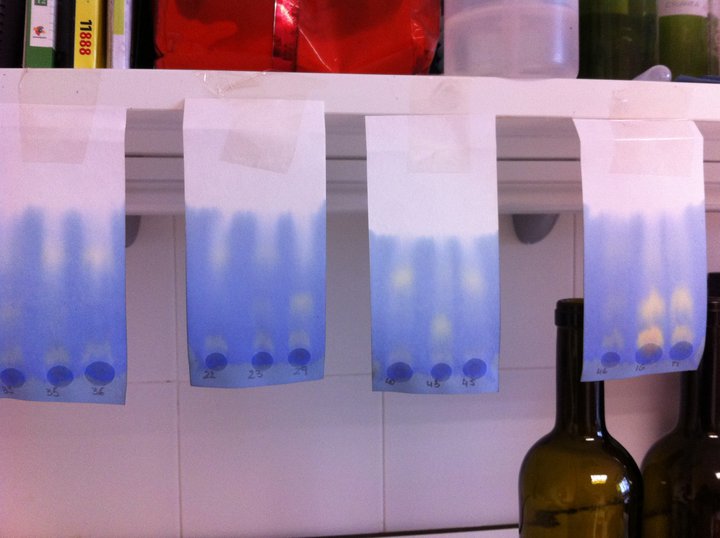You will be able to see our chapter number twelve very soon. There we will explain you what is malolactic fermentation and its effects on wine. In advance, we would like to explain how we monitor this process, which is triggered spontaneously as a result of the lactic bacteria naturally present in the wine.
You already know that after devatting, that is, after separating the wine from the grape skins, we leave the free-run wine in the deposits while waiting for the malolactic fermentation to start. As we do in all the stages of winemaking, we monitor everything that happens in our deposits, and in this case, we use a paper chromatography test.
What we do is we make a solution of butanol and acetic acid with a bromophenol blue indicator, and get a piece of cellulose paper. Once this solution has been prepared, we wet the paper with a drop of wine and introduce it into the previously mentioned solution (the yellow liquid you can see in the photo). The liquid will ascend the piece of paper, draw the wine’s acids and tint them so we can see them. The further it ascends, the more soluble is the wine’s acid in the liquid. Lactic acid is the most soluble, followed by malic acid and then tartaric acid. Thus, the highest stain on the paper corresponds to lactic acid, the one in the middle is malic acid, and the lowest is tartaric acid.

Here you can see how the liquid ascends as the malolactic fermentation is developed
Malolactic fermentation is the transformation of malic acid into lactic acid, which, on the other hand, is more pleasant on the palate. So, if after performing a chromatography test we see that the stain appears in a very low position, it is because malolactic fermentation has not triggered yet; what we have is tartaric acid. In the measure that we see the stain ascending, it means that malolactic fermentation is progressing, as lactic acid is slowly appearing.
When malolactic fermentation has ended, we will have a more pleasant wine on the palate and a more stable wine from a microbiological point of view.
From here on, we will let you know how we progress in the process of making the red wines. So, stay tuned!

 Español
Español




